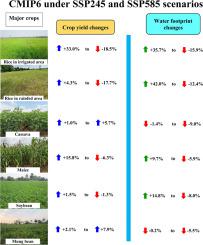Science of the Total Environment ( IF 8.2 ) Pub Date : 2021-10-08 , DOI: 10.1016/j.scitotenv.2021.150741 Noppol Arunrat 1 , Sukanya Sereenonchai 1 , Winai Chaowiwat 2 , Can Wang 3

|
Understanding crop yield and water requirements in response to the future climate at the local scale is essential to develop more precise and appropriate adaptation strategies. From this perspective, repeated drought and flood events in the lower north of Thailand were investigated. The objectives of the study were to evaluate the impact of climate change on major crop yields and the water footprint (WF). Five global circulation model datasets from the sixth phase of the Coupled Model Intercomparison Project (CMIP6), known as Shared Socioeconomic Pathways (SSPs), were selected. Three future periods: near (2015–2039), mid (2040–2069), and far future (2070–2100) under SSP245 and SSP585 scenarios were used to predict the major crop yields and WF changes in the future. The precipitation and maximum and minimum temperatures were projected to increase in all periods under both scenarios. Rice yields in irrigated areas were predicted to rise gradually over the three projection periods under SSP245 but decline in mid and far-future periods under SSP585. There was a predicted reduction of first and second rice crop yields by −6.0% to −17.7% under SSP585. Fortunately, those rice yields were expected to increase in the near-future period under SSP245 by 3.0% to 4.3%. Growing maize, soybean, or mung bean instead of a second rice crop will have a less negative impact on future climate change. Changing from growing rice to be planting maize twice per year and growing cassava had increased favorability in rain-fed areas. The WF changes in the future were associated with future crop yield changes; therefore, the decrease in WFs was due to an increase in crop yield and vice-versa. The total WFs of maize, soybean, mung bean, and cassava production were roughly half that of rice production, indicating that these crops are suitable alternatives in the dry season.
中文翻译:

CMIP6气候预测下泰国反复旱涝地区气候变化对主要作物产量和水足迹的影响
了解作物产量和水资源需求以应对当地未来气候,对于制定更精确和适当的适应战略至关重要。从这个角度,对泰国下北部反复发生的干旱和洪水事件进行了调查。该研究的目的是评估气候变化对主要作物产量和水足迹 (WF) 的影响。选择了耦合模型比对项目 (CMIP6) 第六阶段的五个全球循环模型数据集,称为共享社会经济途径 (SSP)。SSP245和SSP585情景下的三个未来时期:近期(2015-2039)、中期(2040-2069)和远期(2070-2100)用于预测未来主要作物产量和WF变化。在这两种情景下,所有时期的降水量以及最高和最低温度预计都会增加。在 SSP245 下的三个预测期内,灌溉区的水稻产量预计将逐渐上升,但在 SSP585 下的中远期预计将下降。在 SSP585 下,预计第一季和第二季水稻产量将减少 -6.0% 至 -17.7%。幸运的是,在 SSP245 下,这些水稻产量预计将在近期内增加 3.0% 至 4.3%。种植玉米、大豆或绿豆而不是二次种植水稻,对未来气候变化的负面影响较小。从种植水稻改为每年种植两次玉米和种植木薯提高了雨养地区的好感度。未来 WF 变化与未来作物产量变化相关;所以,WF 的减少是由于作物产量的增加,反之亦然。玉米、大豆、绿豆和木薯生产的总 WF 大约是水稻生产的一半,表明这些作物是旱季的合适替代品。











































 京公网安备 11010802027423号
京公网安备 11010802027423号